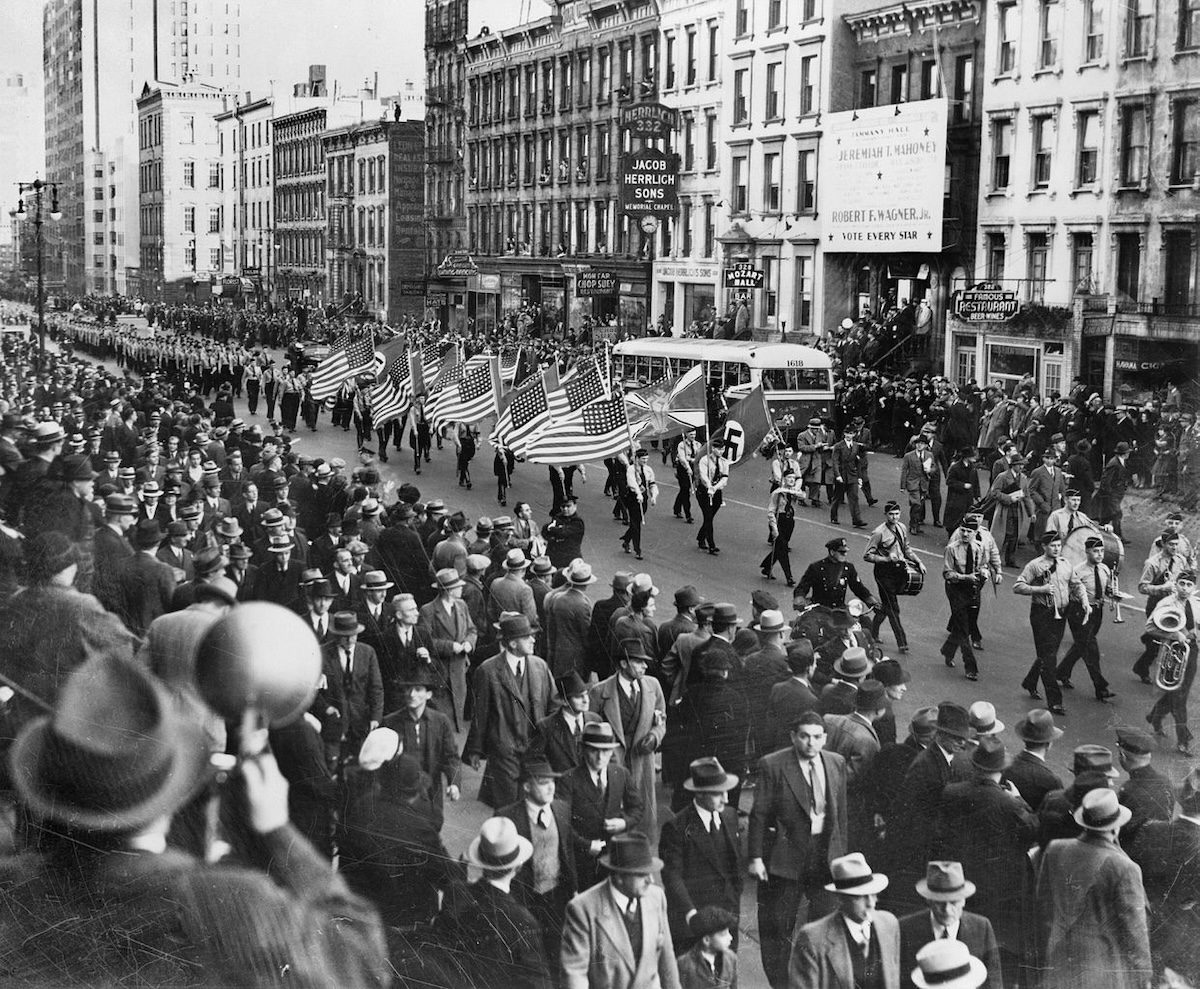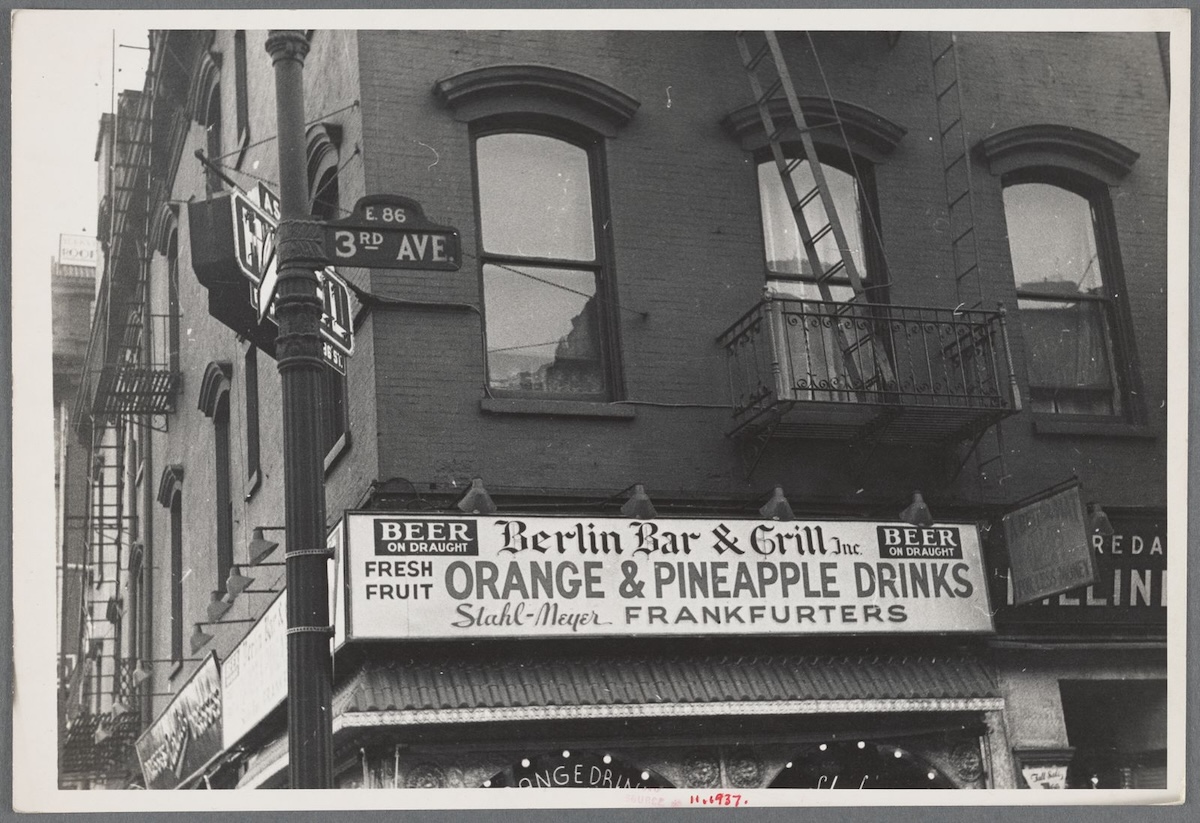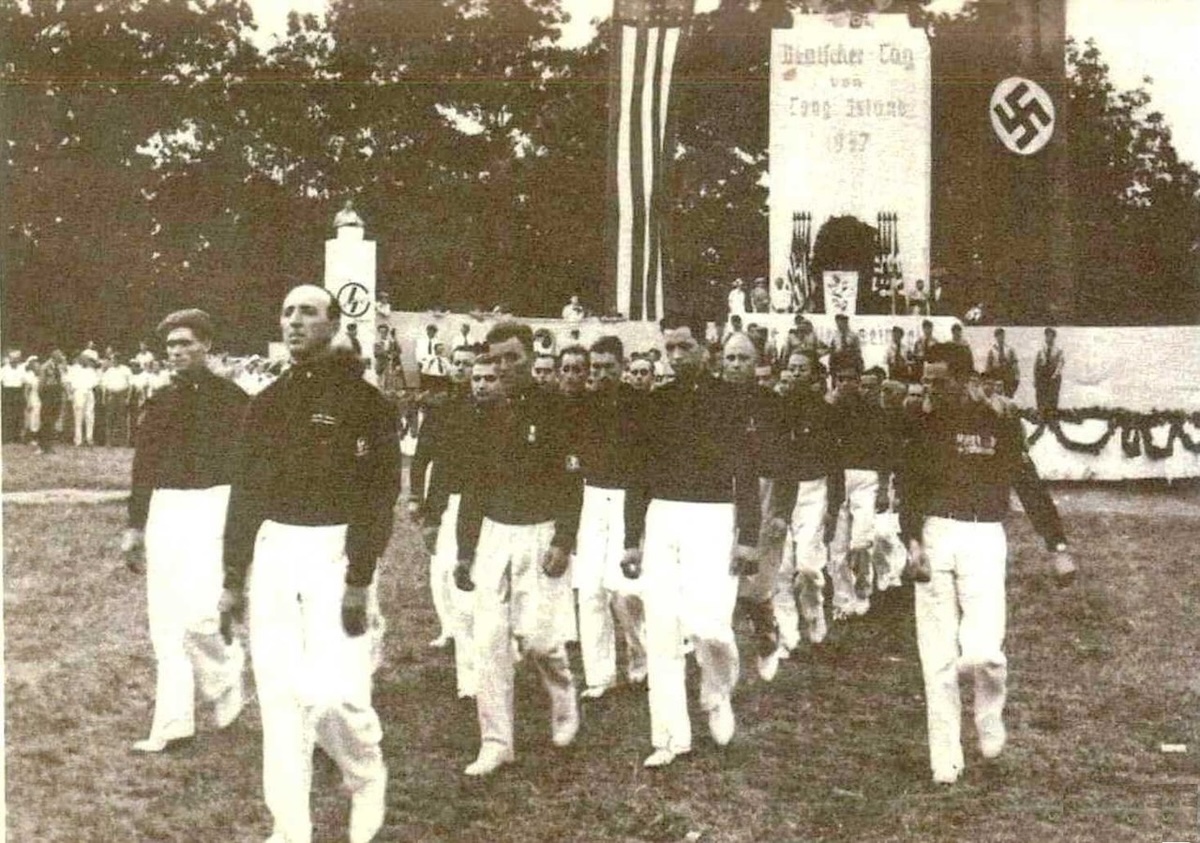Free Upper East Side News + Stories, Delivered To Your Inbox
Where do you start when looking at the past? Leonardo da Vinci once said, “To develop a complete mind, study the science of art; study the art of science; learn how to see; realize that everything connects to everything else” — a fitting lens through which to examine how Nazi ideology found a foothold in Yorkville, the German-American neighborhood on the Upper East Side in the 1930s, before spreading throughout America.
“In the 1930s, lots of Americans thought the whole social order was about to collapse — capitalism, democracy — they were done for, and something else was going to have to come along to take its place,” says historian Beverly Gage in the 2024 PBS documentary Nazi Town, USA. Gage, who won the Pulitzer Prize in 2023 for her biography of former FBI director J. Edgar Hoover, added, “And a lot of people thought that was going to be fascism.”
Advertisement
In the aftermath of World War I, the Roaring ’20s came to define a decade of explosive economic growth in America, amidst sweeping cultural change. The era saw a boom in consumerism, as new technologies like the radio, automobile, and refrigerator became household staples — all while the bold, improvisational sound of jazz became the soundtrack of a generation, ushering in the flappers, sheiks, and others eager to break from Victorian norms and embrace a more liberated modern identity.
However, not everything was as carefree as it seemed. Prohibition (1920–1933) pushed drinking underground, as bootleggers and speakeasies fueled the rise of organized crime and fostered increasing distrust in government. As cracks were forming beneath the surface, Gage describes the 1920s as “an era of deep antisemitism, of legalized racism, [and] of growing inequality across the United States.” By the decade’s end, the good times came to a screeching halt with the stock market crash of October 1929.
The crash erased roughly 90% of the stock market’s value, paving the way for the Great Depression. Unemployment soared to 25% as factories shut down and banks collapsed, eroding public confidence in the financial system. “In the depth of the Depression, a great many Americans started to ask themselves whether the American experiment was failing,” said historian Sarah Churchwell. Some believed it was time for a revolution — and whether that meant democracy, communism, or fascism, all of these ideologies were gaining traction.
Free Upper East Side News + Stories, Delivered To Your Inbox
Cue Fritz Julius Kuhn. Born in Munich in 1896 to lower-middle-class parents, Kuhn was said to have served as a lieutenant in a German machine-gun unit during World War I, according to The New York Times, writing two years after his death in 1953. Kuhn’s 1951 death was only later revealed by his lawyer to The Times, who described Kuhn as “once the arrogant, noisy leader of the pro-Hitler German-American Bund … a poor and obscure chemist, unheralded and unsung.”
When Kuhn’s heart beat, though, he had lofty ambitions. “He presented himself as an American Führer, and his vision was to become the absolute leader — the absolute dictator — of this organization that he claimed was going to take control of the United States,” said World War II historian Bradley Hart. “He imagined that he was going to build a distinctively American version of Nazism, because America’s problem is that it has too many differences.” Hart contends that Kuhn believed there were too many races mingling, too many people speaking different languages — and that the country couldn’t possibly survive in what Hart described as a “crazy state.” Kuhn thought it all should be organized and disciplined under one charismatic leader: himself.
FBI records confirm that the German-American Bund established its headquarters on the Upper East Side in 1936 at 178 East 85th Street between Lexington and Third Avenues. Kuhn saw an opportunity when Berlin shut down the Friends of New Germany in 1935 — a group whose open support of Nazism had sparked fierce opposition.
Advertisement
Among their most vocal opponents were Jewish prizefighters, many with mafia connections, who proudly wore the Star of David on their boxing trunks. “They saw it as their duty to take on the Friends of New Germany in New Jersey. This army of boxers was called the Minutemen, because they could be there in a minute,” said Dr. Stephen Ross. “They would burst into open meetings of the Friends of New Germany and beat the stuffing out of them. In Newark, New Jersey, they were so angry, there was a massive brawl that lasted for hours until the police were able to get it under control.”
ALSO READ: ‘New York Homicide’ Episode Highlights Murdered UES Club Owner
The violence and public backlash led Berlin to formally disband the group — whose members had proudly worn swastikas in support of Nazism and the Third Reich.
Kuhn saw the infrastructure already in place, with chapters around the country, and in 1936, he officially founded the German-American Bund. Dr. Stephen Ross calls this moment “the beginning of star-spangled fascism.” Classic American imagery — like George Washington and the American flag — began to appear alongside Nazi symbols, including the swastika.
A parade was held on East 86th Street on October 30, 1937. Some sources place the event in 1938 or 1939, but the Library of Congress cites 1937. An estimated 800 people marched. While there was opposition — with some in the crowd shouting boos — there were also cheers and raised arms offering “heils.”

German American Bund parade in New York City on East 86th St. Oct. 30, 1937. Photo c/o Library of Congress
“In this Yorkville neighborhood, German was spoken in the streets. The shops had signs in German. If you walked through Yorkville in 1936, you could think you were in a German city,” said Dr. Stephen Ross. And while most German Americans across the country were not supporters of the Bund, it was building a presence here in New York City — one that was deliberately provocative for the Jewish community, with Nazi paraphernalia, including copies of Mein Kampf, seen right outside their homes.

New York Public Library Digital Collections, 1937
Historian William Hitchcock describes Kuhn’s strategy: “Kuhn is trying to change the conversation a little bit by saying you can be a patriotic American and you can be proud of the Nazi government as well.” The Yale Ph.D. adds, “So he is going to try to square the circle, which is to make Americans and American citizens a part of an organization that is basically designed to propagate Nazism.”
At its peak, the German-American Bund claimed as many as 100,000 members, according to the documentary Nazi Town, USA. Thousands more were considered “sympathetic,” attending rallies and events without officially joining.
ALSO READ: Seize the Day with Squadron A: The Upper East Side’s Historic Military Outfit
A little like a McDonald’s Happy Meal — widely considered unhealthy, but made appealing with bright packaging and a toy — the Bund targeted children to help validate its cause. “People can say, well, this is a good organization. It teaches them about the beauty of nature. It teaches them vital skills in life. And it’s family friendly and family oriented. By the way, we hate Jews. We hate Blacks. We hate Catholics.”
Advertisement
Co-ed summer camps for children began to take root, with the largest built by the Bund: Camp Siegfried, nestled in Yaphank, Long Island. While learning practical skills similar to those taught in the Boy Scouts, children could be heard singing camp songs like:
A comrade for battle who stays faithful day and night;
And the world will belong to us!
Those who cannot be faithful shall die,
And life belongs to us!”
The site became a destination for many in the New York area — not just for summer camp, but for rallies, picnics, and gatherings throughout the year. Every Friday, a train called the Siegfried Special ran directly from Penn Station to Long Island, packed with people heading out for the weekend.

Blackshirts marching at Camp Siegfried, in Yaphank, New York, on Long Island, in the 1930s. Photo c/o FBI, public domain via Wikimedia Commons
In Yaphank, the Bund went further, building a planned German-American settlement called German Gardens. Streets were named after top Nazi officials — including Hitler Street, Göring Street (after Luftwaffe chief Hermann Göring), and Goebbels Street (after Nazi propaganda minister Joseph Goebbels). Property laws were written to restrict ownership, explicitly barring Jewish residents from buying homes.
ALSO READ: Upper East Side Locations of Literary Significance
Things hit a breaking point on the evening of February 20, 1939. Billed as a “Pro-American Rally,” the Madison Square Garden marquee was lit up in full sparkle as Nazis and sympathizers filled the area — on George Washington’s birthday, no less.
Once again, but now bigger, louder, and center stage inside one of the most iconic venues in the world, Bund members paraded out American flags, George Washington imagery, and swastikas — all under the same roof.
“The rally opened with the Pledge of Allegiance to the American flag,” wrote NPR, noting that the mood in the room was jubilant. Attendees proudly wore Nazi armbands alongside American flags and held posters with slogans like “Stop Jewish Domination of Christian America.” Storm troopers patrolled the aisles in uniforms nearly identical to those of Nazi Germany.
“It looked like any political rally — only with a Nazi twist,” said Arnie Bernstein, author of Swastika Nation. Protesters charged the stage on several occasions before being ejected from the building. In some video footage of the event, you can see children cheering as Jewish protesters are roughed up.
Advertisement
After the rally, New York Mayor Fiorello LaGuardia was furious that such an event had taken place in his city. He contacted his district attorney, Thomas Dewey, and basically told him to take the gloves off and find any way to lock Fritz Kuhn up.
Dewey’s office uncovered that Kuhn had been embezzling funds from the American Bund to cover personal expenses and maintain a network of mistresses across the country. Kuhn was charged with grand larceny and forgery, accused of stealing around $14,000 from his followers. Ultimately, he was found guilty of embezzlement and tax evasion and sentenced to two and a half to five years in prison.
While serving time in Sing Sing, Kuhn received word that Hitler had invaded Poland, plunging Europe into war once again. Meanwhile, debate raged across the United States over whether to intervene in the conflict. It wasn’t until the Japanese attack on Pearl Harbor on December 7, 1941, that the situation truly escalated. The U.S. declared war on Japan in the aftermath, and just days later, Germany declared war on the United States. Kuhn was eventually deported back to Germany in 1945.
The Smith Act, which makes any group that advocates the violent overthrow of the U.S. government subject to criminal penalties, helped bring the Bund’s downfall. “The Bund, as an organization, collapsed, but of course, the people who were in the Bund didn’t then disappear,” said Beverly Gage. “The end of the Bund just meant that they blended back into American life,” taking on roles as doctors, dentists, police chiefs, and more.
Nazi Town, USA contends that this dark chapter of the German-American Bund serves as a stark reminder that hatred and extremism can take root even in the heart of American communities. While the Bund itself has vanished, the ideologies it championed have never fully disappeared. Understanding this history is not just about looking back — it’s a call to vigilance in the present, to recognize and confront the dangerous forces that threaten democracy and unity today.
Have a news tip? Send it to us here!





Fascinating article. Thank you.
Jan 6 comes to mind-if ever there was an attempt to overthrow our govt.